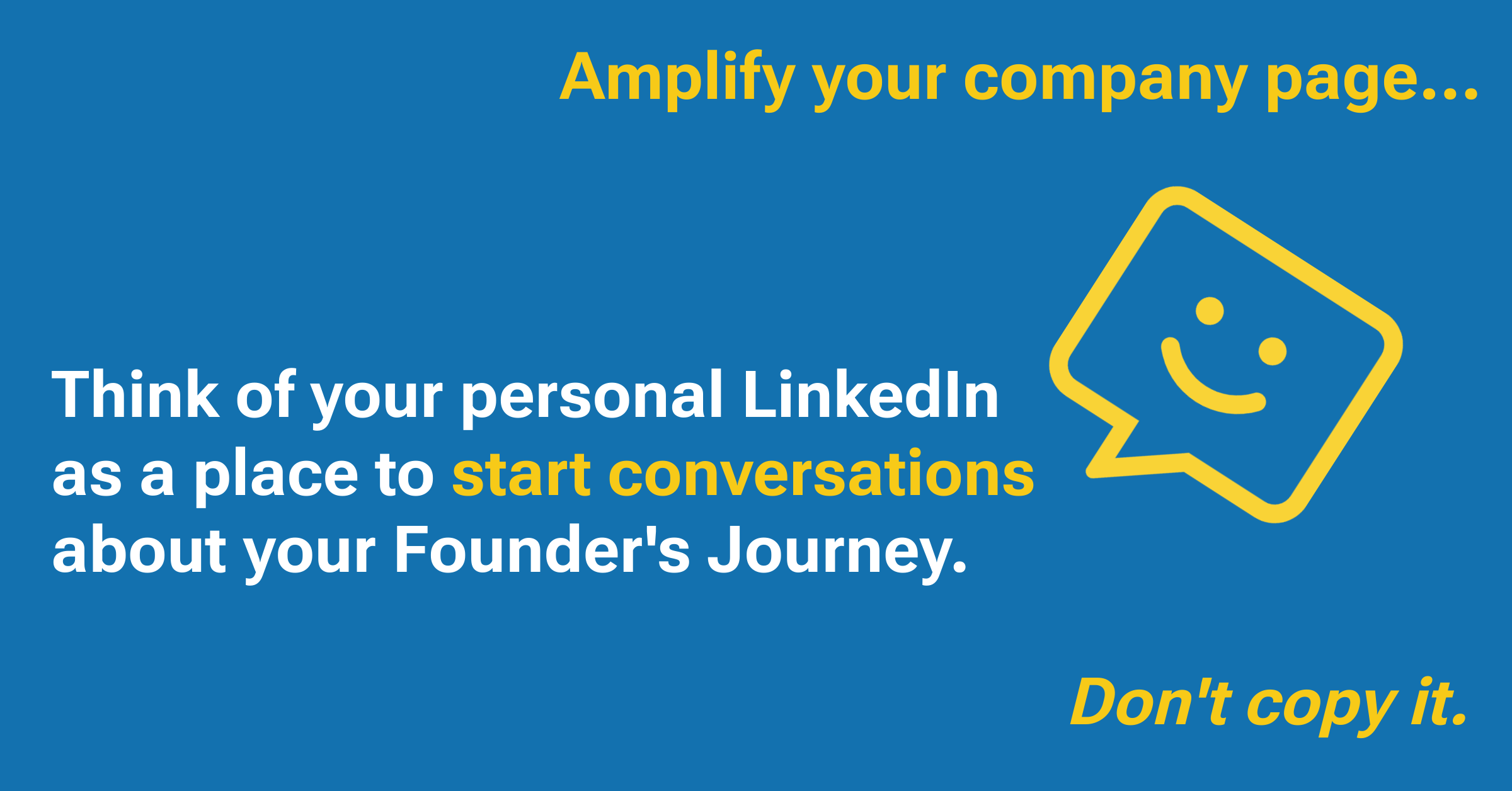Why A Founder’s LinkedIn Profile is a Startup Growth Engine
Your LinkedIn profile is much more than a digital resume
If you’re a startup founder, your LinkedIn profile isn’t just a digital resume; it’s a growth engine for your company. Think of it as your personal megaphone, amplifying your company’s message while establishing you as a trusted voice in your industry.
But here’s the catch: many founders find it really challenging to find time to engage on LinkedIn because they’re incredibly focused on building their companies. They have the basics implemented (a photo with a headline such as “CEO & Founder at Company Name”) which is important. In many cases, their company’s LinkedIn page struggles to gain traction while their own personal posts, when they have the opportunity to post, get far more engagement.
Why? Because people connect with people, not logos.
So, how do you build a LinkedIn profile that works for you and your startup, without sounding like a corporate clone of your company page?
Let’s break it down.
Creating a cadence and content calendar helps streamline messaging.
Your LinkedIn Profile: The Founder’s Must-Haves
Headline: More Than Just “Founder & CEO”
Your headline is prime real estate. Instead of just listing your title, try something like:
“Helping e-commerce brands reduce cart abandonment | Founder @ [Company]”
“Building the future of AI-powered HR | Startup Founder & Recovering Coffee Addict”
A little personality goes a long way.
About Section: Tell a Story, Not a Resume
This isn’t the place for a dry list of accomplishments. Instead:
Start with a hook (a problem you solve, a mission you’re obsessed with).
Show your journey (why you started your company, what drives you).
End with a call to action (How can people work with you? What should they check out?).
Visual Branding: Look Like You Belong
Profile photo: Professional but approachable (no cropped group shots).
Banner image: Reinforce your brand; subtle branding is fine, but avoid a hard sell.
Featured Section: Showcase Your Best Work
Add posts, articles, media mentions, or even a link to your latest product demo. This is where you prove you’re not just talking, you’re doing.
Fast Company shares that CEOs are becoming their own brand ambassadors on LinkedIn, by sharing their personal startup journeys in an authentic way, while still keeping guardrails in place to prevent sharing what’s happening privately in the organization. (1)
Founders have incredible experiences and advice to share.
Amplifying (Not Copying) Your Company Page
Your personal LinkedIn shouldn’t parrot your company page; it should complement it.
Company Page: Official updates, product launches, company culture.
Your Profile: Behind-the-scenes insights, founder lessons, industry commentary.
Example:
Company Post: “We’re thrilled to announce our Series A funding!”
Your Post: “Three brutal lessons I learned raising our Series A (and why almost no one talks about ##2).”
One is an announcement; the other is a conversation starter.
A study by Refine Labs that reviewed LinkedIn post performance found that personal LinkedIn profiles generate 2.75 times more impressions and 5 times the engagement of company pages, even when the company page has a greater number of followers. (2)
Content Strategy: Solve Problems, Don’t Sell
Nobody logs into LinkedIn to see ads. They come for insights, connections, and solutions.
Post about your audience’s pain points (not your product’s features).
Share lessons learned (failures included, because they humanize you).
Be a teacher, not a pitchman.
Bad Post: “Our software is the best! Sign up now!”
Good Post: “Why 80% of SaaS companies struggle with onboarding (and how to fix it).”
The second post positions you as an expert—and when people trust you, they’ll check out your company naturally.
Engagement: Be Social
Posting is great, but commenting is where relationships are built.
Celebrate others’ wins (genuine congratulations go far).
Add value to discussions (don’t just say “Great post!”, expand on an idea).
Avoid negativity (that whole “If you can’t say anything nice…” adage is 100% applicable here).
PRO TIP: Strategic Posting & Commenting
LinkedIn’s algorithm prioritizes meaningful, original content and rewards thoughtful, relevant commenting on other’s posts. How many times should you post each week? Depending on what you’re sharing, 1 to 2 times a week is ideal. Flooding feeds with low-value posts (sales, repetitive or irrelevant) may dilute your reach and visibility.
Start Small, Stay Consistent
You don’t need to post daily or overhaul your profile in one sitting. Start with:
A stronger headline.
One thoughtful post per week.
Five genuine comments on others’ posts.
Over time, your LinkedIn presence will grow—and so will your startup’s visibility.
Need help refining your personal or company’s LinkedIn strategy & content? #LetsChitChat
Sources
(1) https://www.fastcompany.com/91060955/how-ceos-are-using-linkedin-to-become-their-own-brand-ambassadors
(2) https://www.refinelabs.com/article/personal-linkedin-engagement-vs-company-page
Authored by Melissa Daley, CMO

